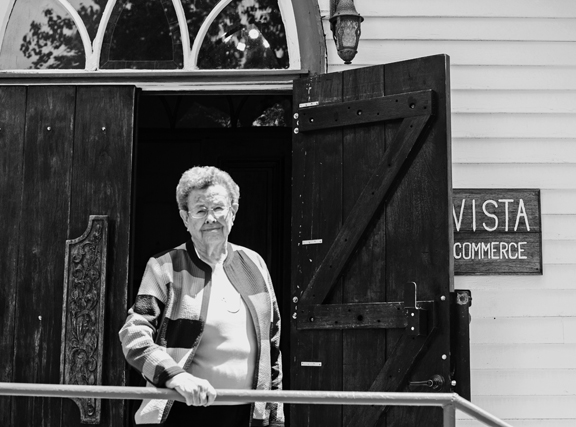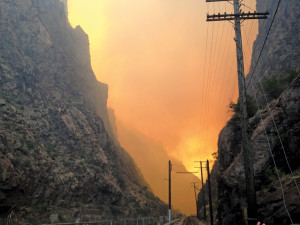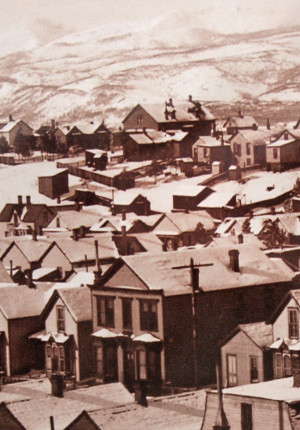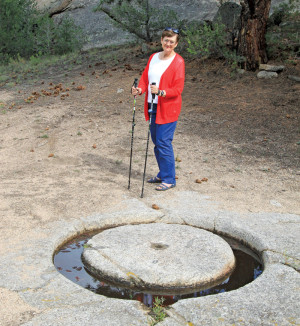Conducted by Tyler Grimes
Billie Love’s grandfather fought with, and fell behind, Lt. Col. George Armstrong Custer’s regiment and lived to tell the tale. Her father was a brick mason who worked on notable Chaffee County buildings such as the Buena Vista Correctional Facility, the Smeltertown smokestack, and Salida Middle School. When Franklin D. Roosevelt came through Salida by train, she – and most of the town – saw her father, dressed in his work attire, meet the President. For Love, it’s easier than most to see the Arkansas Valley through the lens of history.
Love works at the Chamber of Commerce in Buena Vista, where she met me to share some of her stories.
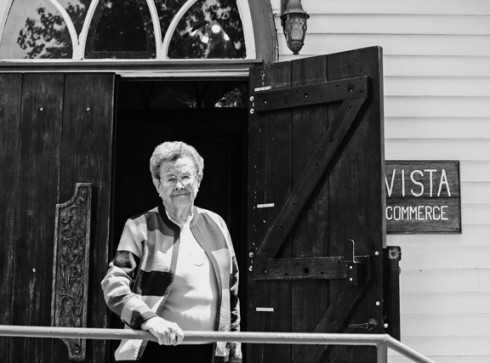
Colorado Central: You’re from Salida?
Billie Love: I grew up in Salida. I was born and raised there, yes.
CC: Where did you go to school?
Billie: I went to school at the University of Colorado, and then I moved to Texas.
CC: For how long?
Billie: We were actually in Texas for 43 years.
CC: What kind of job were you working?
Billie: My husband John Love was a Civil Engineer with the Bureau of Reclamation.
CC: And what do you do at the Buena Vista Chamber of Commerce?
Billie: What don’t I do at the Chamber? (laughs) I’m the volunteer coordinator and I handle the mail room and I handle the vendors during gold rush. Ha, what else do I do? Anything that comes along.
CC: You had a grandfather who was in Custer’s Regiment?
Billie: My grandfather, George Allen came out here first. And I’m not exactly sure when. My father came to Salida in 1895.
CC: Your grandfather came to Colorado first?
Billie: He came earlier than that, it was sometime in the early 1890s.
CC: From where?
Billie: Nadaway County, Missouri … It’s on the Iowa line.
CC: Was your grandfather in the military?
Billie: Yes, you might say my grandfather was in the military. He was with Custer’s regiment and he got sick and they left him behind. He was on his way to join them again when he recovered, this was when he was in Missouri. And he was on his way to the Little Big Horn (Montana) to catch up with the regiment and found out they had all been killed. So he turned around and went back to Missouri.
CC: How did he travel?
Billie: He had a horse when he was going to catch up with Custer.
Several years ago I went to Ness City in Kansas and there was a three- or four-story building that was a bank, and they had big signs outside the town about the “skyscraper of the west.” My grandfather built that building and we got to go through it. My dad was 12 years old at the time and the water boy on that project.
CC: Did you ever meet your grandfather?
Billie: I never met him. He moved back to Missouri before I was born and that was during the Depression and no one had the money go anywhere, so I never met him at all. We didn’t use the car much because we couldn’t afford the gas.
One of the things I remember the most – I was a little kid then – was when they built the school out at Smeltertown, my dad knew the man who was the head of the schoolboard there, Cecil Case, and he said he would call my dad as soon as the meeting was over to let him know whether he got the contract or not. My dad paced in the kitchen all evening long. And he got the contract.
CC: That building is still there?
Billie: Yes, it’s not a school anymore, but it’s still standing. It was a night club for a while, and I don’t know what it is now, but the building is still there. And right after the war, if you notice particularly there on F Street, there are a lot of buildings that are cream-colored brick with a red brick trim, those are homes. My dad made those as well.
CC: And those are your dad’s bricks?
Billie: No, in those places, there used to be a brick company out of Pueblo. Dad used his bricks mainly for backing and bought brick from Robinson in Pueblo. One of the fellows I went to high school with lives in one of those homes.
CC: Tell us about some of the changes you’ve seen in Buena Vista and in the Arkansas Valley.
Billie: When I was growing up in Salida, I’d say that half of the men in Salida worked for the railroad. I graduated in 1945, so I think that’s the most major change I’ve seen. It’s gone from a railroad community to more of a tourist community. Buena Vista was a place we came for Head Lettuce Days. They had a big parade and the prisoners from what was then the Colorado State Reformatory barbecued beef, and up here in the park, why, they served dinner to everyone who came. And then there was a big rodeo out at the rodeo grounds.
CC: Which park was that?
Billie: McPhelemy Park. McPhelemy Park’s always been there. In fact, there used to be a big community building there, a log building. And we had 4-H clubs that concentrated on sewing and cooking. Where the depot is now. Where the highway and Main intersect.
CC: No one was afraid to eat prison barbecue? I’d imagine that wouldn’t go over well now.
Billie: Like I say, it was the Colorado State Reformatory for boys and it was primarily teenagers more than anything else. The old buildings that are out there now, my father had the contract for building there. I remember we used to come up and bring him lunch from Salida.
CC: When was that built?
Billie: It was like, right after the war they built those buildings. Actually it was a while after that when it became the Buena Vista Correctional Facility. It’s gone through a couple different names.
Your dad was in construction?
Billie: Yes, he was. His name was W.H. Allen and he was the foreman on the smokestack.
CC: Do you remember that?
Billie: No, I wasn’t born then; that was 1917. I think he built the one here first. And he was on the one in Anaconda, Montana; he was on that project as well. My dad was a very young-looking man for his age. I think when he went out to Morency, Arizona he was in his 70s. That would be a little too old for a man to be working.
He just always sort of gave people the age he thought he looked like … he died Salida in 1952.
CC: And he worked up until his death?
Billie: The day before he died he had contracted to do a job at Climax Mines, working on their furnaces I believe. Shortly after he got to Climax he had a heart attack. They brought him back to Salida and he died the next day.
CC: Did he work on other notable buildings in the area?
Billie: Kessner Junior High in Salida, I think it was in the early 1930s. My grandfather built the old, old high school in 1912.
Out at the end of D Street there used to be a brickyard. And my grandfather started burning bricks there and many of the buildings in Salida are built with those bricks. When my grandfather went back to Missouri he left that to my dad. As a young kid I remember my dad burning bricks out at the brickyard.
CC: Why did you choose Buena Vista over Salida when you came back?
Billie: Well there are several people who still live in Salida who I went to school with and that’s what they want to know and I tell them it’s quieter. Salida’s not the town I grew up in.
It was basically people who came there early in their lives to work on the railroad, and we all knew each other, and it was a place where you could, I mean everybody walked. We walked to town. The town was mostly where the Historic Downtown is now.
Coincidently, the Sandusky Building downtown was built by my father … So there’s a lot of downtown that my grandfather and my father built.
My dad was a good Democrat and in 1936, when Roosevelt was campaigning for a second term, he came through Salida on a train. Of course, they made this stop and everyone in town went down to the depot to greet the President. Senator Ed Johnson was there, he was a good friend of my dad’s. And the high school band was playing; my sister was in the band, but I was a little kid. My mom and I had gone down to see the President. And my father had been working on a job someplace and he came down covered in mortar. My sister was embarrassed but I thought it was wonderful when Ed Johnson invited him up and he said, “Bill, come on over here, I want you to meet the President.” So he did.
Roosevelt was crippled so he never really came out like we see politicians do today. He was seated on the back of this car at the end of the train. It was just people that were pretty active in the party or well- known that were on the platform, and then my dad got to go up there and meet him.
CC: Was your father was politically active?
Billie: At one time he was the Chaffee County Chairman, and a delegate to the Democratic Convention that nominated Woodrow Wilson. That was 1912. That was a few years ago, a hundred to be exact.
So anyway, my sister was embarrassed to see her father in his dirty overalls, but all I could think was there’s my father up there with the President.
CC: How old were you?
Billie: Well, let’s see that was ‘36 so I would’ve been eight years old. So I probably would’ve been a third grader.
CC: Global warming is a big issue that people are talking about, is that something you’ve seen over your lifetime?
Billie: I really think so, particularly this area. We had that big snow a few years ago. We used to have a lot more snow than we do. We used to have some big snows in Salida. In fact the day of Roosevelt’s funeral, it must have been 1945 because I was in high school, it was in April. Everyone was asked to have a memorial at the same time that they were having Roosevelt’s funeral. The snow was up over the height of the fences and we had the memorial at the high school and everyone walked in the car tracks.
CC: What are other ways has the area changed since you were growing up?
Billie: I think that it was a more stable – particularly after the war – well even during the war, that’s actually when the economy improved. There were a lot of the railroad men that were on the extra board and they were only called in when they needed someone. After the war they had more regular runs. But during the depression they had a few employees that had regular jobs because they were carrying from the mine, but the majority were on the extra board. The quarries were running up at Monarch and they were hauling granite out of here, Salida granite used to be very prized. There’s an old building near the narrow gauge track; it was a store where the granite works was, and I believe it was on Seventh Street, right there where it goes up to the mesa.
I think Salida has more crime now than it did then. (chuckling) At that time we had, I think, two policemen – one on duty during the day and one at night, and I don’t think that’s true anymore.
My dad liked to, when it was snowing, get up in the night and go out and see how much it snowed, because it determined whether he would work or not the next day. He got up in the night – he always slept in his long underwear – and went out on the front porch and the door slammed behind him and it locked. He tried to wake my mom and my sister and I up, but he didn’t have any luck. He had a tool shed in the back and he got his tools out and he took the bathroom window out. He was just disappearing through the window and our neighbor had come home, because he worked for the railroad and worked strange hours, and all he saw was a pair of legs hanging out the window. So he called the one policeman and he came to our house looking for our burglar that was actually my father.

